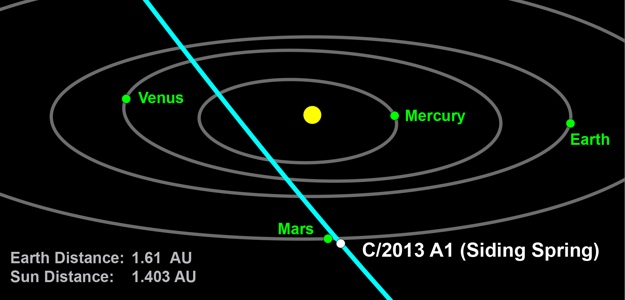 By now, it’s likely that even most paranoid people would agree that NASA and other scientific bodies have proven to the world that we are – barring unforeseen developments best not to think too hard about – unlikely to be hit by a meteor any time soon. That doesn’t mean that collision worriers can relax entirely, because NASA is now suggesting that Mars is the real target for a close call with an age-old comet next year.
By now, it’s likely that even most paranoid people would agree that NASA and other scientific bodies have proven to the world that we are – barring unforeseen developments best not to think too hard about – unlikely to be hit by a meteor any time soon. That doesn’t mean that collision worriers can relax entirely, because NASA is now suggesting that Mars is the real target for a close call with an age-old comet next year.
The comet in question, Comet 2013 A1 (Siding Spring), is projected to come within 31,000 miles of Mars towards the end of next year, according to an estimate from the Near-Earth Object Program Office at NASA’s Jet Propulsion Laboratory in California. “At present, Mars lies within the range of possible paths for the comet and the possibility of an impact cannot be excluded,” the Near-Earth Object officials explained in a statement on Tuesday, although the team admits that the odds are currently not in a collision’s favor. “Since the impact probability is currently less than one in 600, future observations are expected to provide data that will completely rule out a Mars impact.”
It would, admittedly, be a sad end to the journey of Siding Spring to crash into the surface of the Red Planet next fall (NASA scientists believe the fly-by will happen sometime around October 2014); the team at the Near-Earth Object Program estimated that the comet has been traveling through space for more than a million years prior to its discovery by scientist Rob McNaught at the Siding Spring Observatory in Australia in January of this year. Later examination of earlier images uncovered more proof of the comet’s journey, going back to October 2012, that had previously been missed.
The discovery of these earlier photos allowed the NASA team to plot a projected flight path for the comet; the team currently believes the comet will not only not hit Mars itself, but that it will be more than two-and-a-half times farther from the planet than its outermost moon, Deimos. Despite that distance, NASA boffins anticipate that it would be entirely visible during fly-by to someone (or something; we can only hope that the Curiosity Rover is on the correct side of the planet at the time) on the surface of Mars, but warn that we may have a little bit more difficulty from here on Earth. Down here, “the comet is not expected to reach naked eye brightness,” according to the statement from the Near-Earth Object Program, “but it may become bright enough (about magnitude 8) that it could be viewed from the southern hemisphere in mid-September 2014, using binoculars, or small telescopes.”
Of course, should the comet actually impact Mars next October, we can only hope the event might be slightly more visible.
Editors' Recommendations
- Final communications sent to the beloved Ingenuity Mars helicopter
- NASA is looking for volunteers for yearlong simulated Mars mission
- NASA regains communications with Mars helicopter Ingenuity
- How to watch the Quadrantid meteor shower hit its peak tonight
- See the passing of a day on Mars with the Curiosity rover


